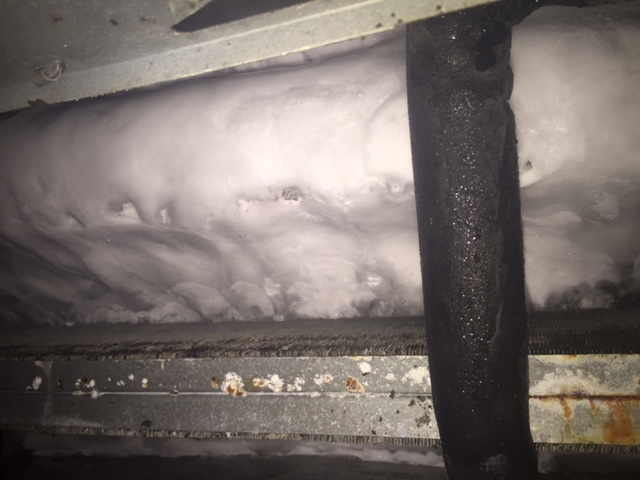What to Handle a Frozen AC Pipe - Essential Steps for Recovery
What to Handle a Frozen AC Pipe - Essential Steps for Recovery
Blog Article
Have you been trying to find resources around What Causes AC Pipes To Freeze??

Introduction
Discovering that your air conditioner pipeline is frozen can be worrying, particularly during warm summer season when you rely on your air conditioning unit one of the most. Understanding what to do in such a scenario is important to stop additional damages to your cooling system and guarantee your comfort inside your home.
Recognizing the Causes
Several elements can contribute to the cold of an AC pipe. Understanding these reasons can assist you address the concern efficiently.
Absence of Airflow
One common root cause of a frozen a/c pipe is inadequate airflow. When the airflow over the evaporator coil is restricted, it can cause the coil to drop below freezing temperature, resulting in ice formation on the pipeline.
Reduced Refrigerant Levels
Inadequate cooling agent levels in your a/c system can additionally result in an icy pipeline. Low cooling agent levels can trigger the stress in the system to drop, bring about the cold of moisture on the evaporator coil.
Cold Weather Conditions
In cooler environments, freezing temperature levels outside can contribute to the freezing of air conditioner pipes. If your air conditioning unit is not appropriately protected or if there are leakages in the ductwork, cool air can infiltrate the system, causing the pipe to ice up.
Dirty Air Filters
Dirty or blocked air filters can restrict airflow in your AC system, bring about numerous concerns, including an icy pipeline. It's important to replace or cleanse your air filters regularly to make sure correct airflow and avoid ice build-up.
Indicators of a Frozen AC Pipe
Acknowledging the indicators of an icy air conditioning pipe is essential for prompt action.
Reduced Airflow
If you observe a significant decrease in air flow from your vents, it can show an icy pipe.
Ice Buildup on the Pipe
Visible ice buildup on the cooling agent line or the evaporator coil is a clear sign of a frozen AC pipe.
Weird Sounds from the Unit
Uncommon sounds, such as hissing or gurgling, coming from your AC device can indicate that there's ice present on the pipe.
Immediate Actions to Take
When confronted with a frozen a/c pipeline, it's important to act swiftly to stop additional damage to your air conditioning system.
Switching off the air conditioning
The very first step is to shut off your a/c unit to stop the system from running and exacerbating the issue.
Checking for Blockages
Evaluate the area around the interior device for any kind of obstructions that may be blocking airflow, such as furniture or drapes.
Defrosting the Pipe
You can make use of mild approaches like positioning towels taken in warm water around the frozen pipeline to assist thaw it slowly.
Safety nets
Taking preventive measures can aid avoid future occurrences of an icy AC pipeline.
Routine Maintenance Checks
Arrange regular maintenance talk to an expert HVAC specialist to ensure that your air conditioner system is running effectively.
Altering Air Filters
Frequently replace or cleanse your air filters to avoid air movement limitations and preserve ideal efficiency.
Insulating Exposed Pipes
If your a/c pipes are subjected to cool temperature levels, think about shielding them to prevent cold during cold weather.
Seeking Professional Help
If DIY approaches fail to resolve the problem or if you're unclear about just how to continue, it's ideal to look for aid from a certified HVAC professional.
When DIY Methods Fail
If your attempts to thaw the pipeline or address other issues are not successful, it's time to employ an expert.
Importance of Hiring a Professional HVAC Technician
A qualified HVAC specialist has the knowledge and tools needed to diagnose and fix concerns with your a/c system safely and successfully.
Verdict
Handling an icy AC pipe can be a discouraging experience, but knowing exactly how to respond can assist lessen damages and recover convenience to your home. By recognizing the reasons, identifying the indicators, and taking punctual activity, you can successfully attend to the problem and avoid future occurrences.
What to Do If Your AC Line Is Frozen
Make Sure All Supply and Return Air Vents Are Open
If you notice problems with airflow, the first thing you should do is check your supply and return vents. Supply vents distribute clean, conditioned air throughout your home. As this air becomes stale, it’s pulled into the return vent, where it’s reconditioned before being sent back out through the supply vent.
When these vents are closed, air won’t flow in the home. Before examining your AC, check the vents in every room and ensure they’re all open.
Check for a Dirty Air Filter
Another possible cause of limited airflow is a dirty air filter. Your air conditioner’s filters catch elements you don’t want to breathe in, such as dirt and dust. Over time, filters can become clogged, ultimately blocking air from flowing in and out. The lack of airflow can then cause the entire coil to freeze and will completely restrict any air from moving through it. The AC may need to be powered off for one to two days to allow the coil to thaw after replacing the filter to allow proper functioning of the unit. This debris can also accumulate on your AC’s evaporator coil, requiring a more serious repair. In general, air filters should be cleaned regularly (about every two weeks).
Assess Your Outdoor Unit
In addition to checking your AC, assessing the outdoor unit is a good idea. Also known as the condensing unit, it works with your interior unit to release heat outside. An issue with the outdoor unit can result in rising internal temperatures.
Overgrown Shrubs or Clogged Leaves
From leaves and twigs to shrubs and debris, there’s no shortage of outdoor elements that can accumulate around your condensing unit. When these elements get lodged inside the unit, they can block airflow. Fortunately, removing the blockage can solve the problem.
Sounds of a Broken Fan
Shrubs and leaves aren’t the only things that can impede your outdoor unit’s airflow. If the fan is broken, the unit won’t be able to properly get rid of heat — which means the internal temperature won’t go down. First, make sure the fan is spinning. If it is, check for the following sounds of a broken fan:
Buzzing Rattling Screeching Hissing Clicking Preventative Measures
Nobody wants to deal with a frozen AC line. In addition to causing problems with your air conditioner, they require professional repairs. On the bright side, there are preventative measures you can take to help ensure this issue doesn’t arise in the first place.
https://www.coopergreenteam.com/blog/what-to-do-if-ac-line-frozen

Do you appreciate reading up on What Do I Do If My AC Pipe Is Frozen? Create a remark further down. We would be glad to know your responses about this posting. We are looking forward that you visit us again later on. Sharing is caring. You won't know, you may be helping someone out. We truly appreciate reading our article about Why Is Ice On My Outside Air Conditione.
Visit Our Website Report this page